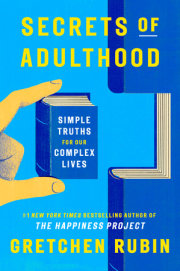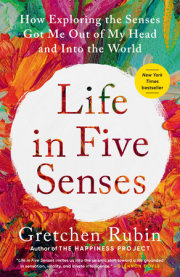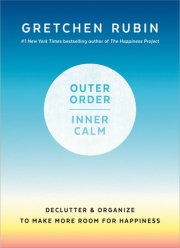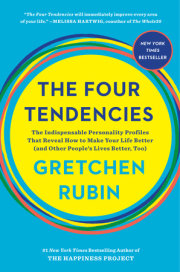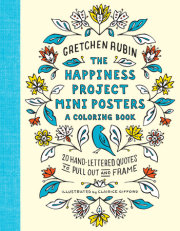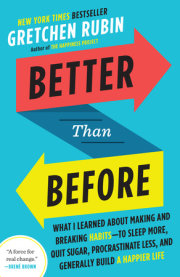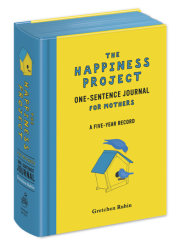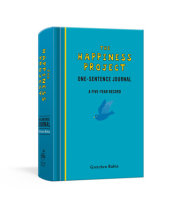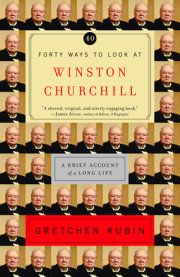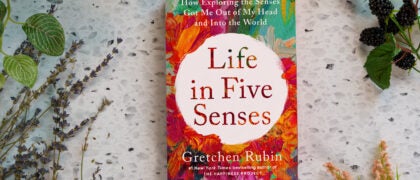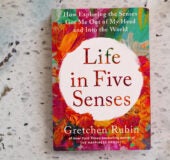September
Possessions
Find a True Simplicity
We need to project ourselves into the things around us. My self is not confined to my body. It extends into all the things I have made and all the things around me. Without these things, I would not be myself.
—Carl Jung, C. G. Jung Speaking
Once the season of the harvest, now the season of la rentrée, September has always been a milestone month for me, and this September had particular significance: After the first week of school, Eliza walked to school alone. Although she has a safe walk of just nine blocks, we both were nervous the first time she left by herself, but after that morning, she was thrilled with her new independence. The change was bittersweet for me, because I would miss our time together.
Oh well, I comforted myself, Eleanor was just starting kindergarten; I still had many years of morning walks ahead of me. Last May, at the end of nursery school, Eleanor had seemed so big, but in her new school, she was little all over again. As I led her into her classroom on that first morning, I loved seeing the construction-paper decorations, the block area and the dress-up clothes, the rows of carefully labeled cubbies. Already, I felt deeply sentimental.
When I considered how to be happier at home, I thought first of Eliza, Eleanor, and Jamie. The contents of my home and its architecture mattered much less than its occupants. But while home was the people in it, it was also the physical space and the objects that surrounded me there. I decided to start my happiness project with the theme of “Possessions,” not because I thought possessions were the most important aspect of my home—they weren’t—but because I knew that in many cases, my possessions blocked my view and weighed me down. Before I wrestled with deeper challenges that struck closer to my heart—in the months devoted to “Marriage,” “Parenthood,” and “Family”—I wanted to feel more in control of stuff.
My theme of “Possessions,” however, wouldn’t extend to furniture, wallpaper, bathroom tile, or any permanent aspect of the apartment. Although I knew that many people might be eager to address the home-decor aspect of home, I’d never been interested in interior design—window treatments, kitchen countertops, or anything else—that is, until I read the haunting, evocative book A Pattern Language. In it, visionary architect Christopher Alexander and his team identify 253 “patterns” that repeat through the architecture that people find most pleasing. As I read about these patterns, I began to fantasize for the first time about living in a dream house, one that incorporated patterns such as “Sleeping to the East,” “Staircase as a Stage,” “Garden Growing Wild,” “The Fire,” and “Private Terrace on the Street.” I wanted them all. But although Alexander’s grand system of archetypes enthralled me, our current apartment either had elements such as “Window Place” or “Sunny Counter,” or, in most cases, it didn’t. For this month of Possessions, I would limit myself to the movable objects inside our apartment.
Within the larger subject of happiness, the proper relationship of possessions to happiness is hotly debated. People often argue that possessions don’t—or shouldn’t—matter much to happiness, but I think they do.
Some research suggests that spending money on an experience brings more happiness than buying a possession, but the line between possessions and experiences isn’t always simple to draw. The latest pair of skis is tied to the fun of skiing, and a fashionable dress adds to the fun of meeting friends. A camera is a possession that helps keep happy memories vivid—a big happiness booster. A dog is a possession, an experience, a relationship. Also, many wonderful experiences require, or are enhanced by, possessions. Camping is easier with a great tent. Throwing a Halloween party is more fun with wonderful decorations. Choosing postcards enhances the pleasures of traveling. Part of the fun of fly-fishing is picking out the equipment. Also, for many people, shopping itself is an enjoyable experience; acquisition of possessions is part of the fun, but not all of the fun.
People’s desire for possessions can change over time. A friend told me, “For years, I loved the feeling that I could pack up my apartment in an afternoon, load it into my car, and drive away.”
“Like that character in the movie Sex, Lies, and Videotape, who said, ‘I just like having the one key,’ ” I said.
“Exactly! I felt so free. I could do anything, go anywhere.”
“Do you still feel that way?”
“No,” he said. “Over time, I’ve started to want to have more things. I’m still single, so I can live any way I want, but now I want to be settled someplace, with my things around me.”
We often deny the importance of possessions, or feel embarrassed by our enthusiasm for them, but the desire to possess has roots very deep in human nature. “Although there are a few societies in which notions of ownership are absent or downplayed,” observe researchers Gail Steketee and Randy Frost in Stuff, “in most cultures the interaction between people and their things is a central aspect of life.”
Of course, the practice of denying the importance of possessions is also ancient, and many cultures extol the principle of nonattachment and the relinquishment of worldly goods. It’s certainly true that possessions, or the desire for possessions, can undermine happiness, and that some people are happier when they own very little. I once had a long conversation with a twenty-three-year-old guy who tried to convince me how happy I’d be if only I would downsize to one backpack of stuff. “I can’t tell you how much more serene I feel, now that I’ve gotten rid of practically everything,” he said earnestly. “It’s the answer.”
“For you,” I said, with a laugh. “But it’s not the answer for everyone.”
For me, I knew, possessions had a role to play. In fact, one of my goals for the month was to glean more happiness from my possessions.
The fact is, attachment brings happiness, and attachment brings unhappiness. Love—for people, for possessions, for a place, for an animal, for a house, for anything—exposes us to the pain of loss. It’s inescapable. We can mitigate that pain by moderating or even eliminating attachment, but while something is gained, something is also relinquished. I wanted to love my possessions, and yet not be mastered by them.
In the persistent debate over the proper role of possessions and spending, I often heard the argument “It’s awful; people are so materialistic. They think that money and buying things can make them happy, but they can’t.”
This statement contains more than one idea. The first idea is that “Money can’t buy happiness.” True, money can’t buy happiness, but spent wisely, it can buy things that contribute mightily to a happy life. People’s most pressing worries include financial anxiety, health concerns, job insecurity, and having to do tiring and boring chores, and money can help to relieve these problems. Money can help us stay close to other people, which is perhaps the key to happiness. It can help us support causes we believe in. It can help us pursue activities that bring us happiness, whether raising children, planting a flower garden, or planning a vacation.
The second idea is that people (not us or our friends, of course, but other people) are too “materialistic,” that is, they place too much importance on owning things and showing them off. True, people who are materialistic tend to have unrealistically high expectations of the power of material things, and they seek to define themselves, or raise their status, or make themselves happier through possessions. Studies show that highly materialistic people are less happy, though which is the cause and which is the consequence isn’t clear.
However, in some situations, behavior that might outwardly seem “materialistic” has a nonmaterialistic cause. Conspicuous consumption doesn’t explain every flashy purchase. For instance, I have a friend who’s always the first to buy the latest gizmo—not to show that he can afford it, but to feed his fascination with technology. Clothes are a puzzle. Some people appreciate beautiful clothes for their own sake; it’s not all about making a display for other people, though that’s part of it, too. Virginia Woolf noted in her diary: “But I must remember to write about my clothes next time I have an impulse to write. My love of clothes interests me profoundly; only it is not love; and what it is I must discover.” Is this love purely “materialistic”?
For better or worse, buying things (or photographing them, cataloging them, or writing reviews about them) is a way to engage with the world. When we’re interested in something, we often express that interest by researching, shopping, buying, and collecting. People who love art go to museums, but when they can afford it, they usually want to buy art, too. People who love to cook enjoy buying kitchen tools and exotic ingredients. The latest sports equipment probably isn’t much different from what’s already in the closet. We crave to buy and possess the things we love, even when it’s not necessary. I’m interested in reading The Autobiography of Benjamin Franklin only every so often, and my neighborhood library has two copies, yet I want my own copy. When we possess things, we often want to show and share them with other people. Is that necessarily “materialistic” behavior?
Many of the most precious possessions are valuable not because of their cost or prestige, but because of the meanings they contain; modest trinkets, homemade objects, worn books, old photographs, whimsical collections. (After someone’s death, how strange to see the value drain away from his or her possessions; useful household objects such as clothes, or dish towels, or personal papers become little more than trash.)
Because we often want to deny the importance of possessions, and because we don’t want to seem materialistic, we often don’t spend enough time and attention thinking about how possessions could boost happiness—or at least I didn’t. My possessions had a powerful influence over the atmosphere of my home, and they contributed to, and reflected, my sense of identity.
Was it possible to be happy with very few possessions? Yes. Were some people happier when they owned almost nothing? Yes. But for most people, including me, possessions, wisely chosen, could be a boon to happiness.
Possessions have a role to play in happiness, yet it seemed as though every time I visited a bookstore, turned on the TV, or picked up a newspaper or magazine, I heard the message “You’ll be happier with less!” Whenever I fell into conversation with people about the subject of happiness at home, I often heard the response, “Oh, I need to simplify.”
Some of the great minds in history urge us toward simplicity. Thoreau admonished, “Our life is frittered away by detail. . . . Simplicity, simplicity, simplicity!” This longing for simplicity is so powerful and complex that it needs its own term, much like nostalgie de la boue (yearning for the mud) or wabi sabi (the beauty of the imperfect and impermanent). When I asked on my blog if anyone knew a term to capture this idea, one reader coined the wonderful word “Waldenlust.” This longing takes several forms: fantasies of the freedom that dispossession would bring; nostalgia for earlier, supposedly simpler times; and reverence for the primitive, which is assumed to be more authentic and closer to nature.
I’ve often felt a yearning to escape from the ties of ownership. I’ve wanted to dump the entire contents of a chest of drawers into the trash rather than endure the headache of sorting the good from the bad. I often choose not to buy something useful or beautiful, because I don’t want the responsibility of another possession. Years ago, walking through a convenience store parking lot in some small, nameless California town, I had a sudden vision of abandoning everything, my possessions, relationships, ambition, to disappear, unencumbered. What care I for my goose-feather bed?—I’m away with the raggle-taggle gypsies-o. Sometimes, too, in an eerie, dark reversal, I love something so much that I feel the urge to destroy it, to be free from that attachment and the fear of loss. (I was so puzzled by this impulse that I wrote a book about it, Profane Waste.)
One friend had a particularly acute case of Waldenlust. He was headed to his parents’ house to go through the twenty boxes he’d stored there. “It’s terrible to say, but I really wish there’d be a fire or a flood,” he said ruefully. “Then I’d be done. I hate the thought of dealing with all that stuff.”
“Why are you doing it?”
“My parents are really annoyed. I promised I’d leave the boxes there just temporarily, but they’ve been there a year now.”
“If you haven’t needed anything for a year, maybe nothing’s important,” I said. “If you wish everything would get destroyed in a fire, maybe you could throw the boxes away, without going through them.”
“No, I couldn’t do that,” he shook his head. “I can’t just throw it all away, even if I don’t want it.”
I nodded. I understood the demands of those dusty cardboard boxes. Even though they sat neglected and unwanted, somehow they held pieces of—himself? the past?—that couldn’t be discarded recklessly.
In the past few years, I’d made great headway in conquering my own clutter, but I still wasn’t free from it. The press of superfluous possessions made me feel unsettled and harried, and the demands required by acquisition, use, maintenance, storage, and even relinquishment ate up my energy and time.
However, although I wanted to simplify, I also feared that I was too inclined to simplify. Of course, the virtues of simplicity lay far deeper than mere elimination, yet I saw a danger in my craving; I didn’t want to be tempted to cut away too much.
The first principle of my happiness project was to “Be Gretchen.” One important way to “Be Gretchen” was not to assume that virtues that others strive to cultivate are the ones that I should strive for. Others strive to save; I push myself to spend out. Others try to work more; I try to play more. Others strive for simplicity; I fight the simplifying impulse, because if anything, I cultivate too much simplicity—not a disciplined, thoughtful simplicity, but one created by indifference and neglect.
There’s a lassitude deep in my soul; I always have to fight my urge to do nothing. If I didn’t have to consider Jamie and my daughters, if I didn’t have my mother to coach me along, I’d be living in a studio with bare walls, crooked blinds, and a futon on the floor, forever. For some, that simplicity would seem attractive and perhaps even admirable, but not to me. In my case, it would be the simplicity of evasion and apathy, not the simplicity of beautiful emptiness or voluntary poverty.
I’ve always been this way. After I graduated from college, I lived in a house in Washington, D.C., with three friends. After the first year, one of my housemates said kindly, “The thing about living with you, Gretchen, is that you don’t subtract, and you don’t add. You never leave a mess, and you never bring home a dessert or call the cable guy.” Which was so obviously true that it didn’t even hurt my feelings.
Copyright © 2012 by Gretchen Rubin. All rights reserved. No part of this excerpt may be reproduced or reprinted without permission in writing from the publisher.






